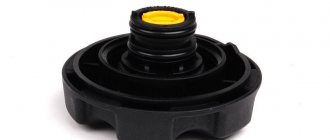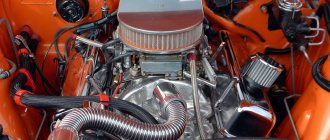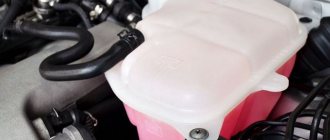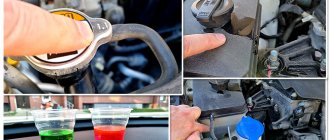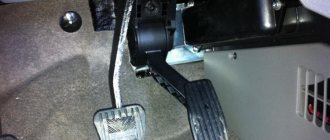The cap of the expansion tank of a car's engine cooling system, as a rule, does not raise suspicions about its serviceability. This, as many people think, very “modest” in importance part is entrusted with a very important task - to regulate the pressure in the cooling system. When the lid stops coping with this, in the best case, liquid will boil or leak out, and in the worst case, this will lead to the breakdown of some components.
- 2 Design and principle of operation of the expansion tank cap
- 3 Signs and possible consequences of a part malfunction
- 4 How to check the cover and identify problems?
- 5 Refinement of a new part - what to do if it does not function?
What is the main role of the tank cap?
As is known, a running engine creates a pressure in the cooling system that differs from normal atmospheric pressure. This occurs due to the fact that the coolant heats up along with the engine, as a result of which it expands and increases in volume. As a result, the pressure inside the engine cooling system (ECS) increases, but it is not in contact with the external environment, and there is nowhere for it to relieve excess pressure.
Developers of modern cars do not fight the increased pressure in the ODS “radically” - they do not try to completely get rid of it. It is adjusted using the tank cap. Increased pressure in the SOD is used to shift the coolant boiling point. After all, it’s no secret that at normal atmospheric pressure for water it occurs at a temperature of 100 °C, for antifreeze – 105–110 °C, and for antifreeze – 120 °C. The operating temperature of modern car engines is very close to these critical values.
Tank cover
So, for example, for carburetor VAZs it should be in the range of 90–95 °C, and for injection ones – 97–105 °C.
However, under certain engine operating conditions, a short-term increase in its temperature occurs to higher values, which, however, does not lead to failure of a serviceable engine, but causes the same heating of the coolant. For example, on injection VAZ 2109 the liquid at such moments can be 120–125 °C. Obviously, even antifreeze cannot withstand such heat. At the same time, an increase in the pressure of any liquid leads to an increase in its boiling point.
Injection VAZ 2109
Engineers designing engines have long found out that to prevent the coolant from boiling even during short-term critical heating of the engine, it is enough to maintain the pressure in the coolant at the level of 1.1–1.5 kgf/cm2 (1.1–1.5 bar). A higher temperature is not needed, because the engine is not designed for it, and it will lead to its failure. And it makes no sense to allow a greater spontaneous increase in pressure, which can nevertheless occur, because it will complicate the process of manufacturing and servicing the motor, as well as increase its cost, since it will require a more durable and sealed SOD (more durable pipes and expansion tank, strong clamps).
Therefore, the tank lid must be sealed, but only up to the required pressure limits indicated above, after reaching which it maintains them, connecting the system with the external environment as necessary to release the air compressed inside the expansion tank.
Conclusion
The article turned out to be quite long and I hope informative.
As you can see, one cap does a huge job and always monitors the pressure in your cooling system, so it needs to be changed approximately every six months. Or at least have a spare cover that is known to work if the installed one suddenly fails.
The design and principle of operation of the expansion tank cap
In order for the necessary pressure to be created in the SOD when the engine is running, the lid device ensures a tight, hermetically sealed closure of the tank. A safety valve is provided to relieve excess pressure. It operates (opens) only when the pressure inside the SOD becomes 1.1–1.5 kgf/cm2 (depending on the design of the lid and its manufacturer).
While it is lower, the valve is closed, and immediately after releasing the excess pressure to a value that is less than that indicated above - partial release of the air compressed in the tank - it closes. There is one more valve in the lid - the inlet valve, it is also called a vacuum valve. Its purpose is exactly the opposite of protective. The inlet valve serves to intake (suction) air into the SOD. The fact is that after stopping the engine, as you know, it begins to cool down. The coolant temperature also drops.
Inlet valve cover
At the same time, it decreases in volume, which is accompanied by a decrease in pressure inside the SOD. The coolant that enters the tank, upon its own heating, begins to flow back into the system, freeing up space for the air remaining in the expansion tank and ceasing to put pressure on it. Then there comes a moment when the pressure in the SOD is compared with the external atmospheric pressure. If at the same time the temperature of the coolant turns out to be higher than in the external environment, then it, continuing to cool, will further decrease in volume.
This will lead to the pressure in the SOD becoming lower than atmospheric, that is, to a vacuum effect. The outside air will put pressure on the elements of the system and will tend to occupy its internal volume. If there is a “weak” place in any part of the SOD, where the tightness is broken when it cools and pressure exerted from outside, then air will enter the system and a so-called air lock may form in it. When the engine is started again, it can, of course, be pushed out by coolant into the expansion tank.
Auto coolant
But if this does not happen, the air lock will disrupt the circulation of fluid in the SOD, prevent the engine from cooling, and may even cause it to fail. Typically, air enters the system due to suction between the pipes and fittings on which they are mounted. To prevent this from happening, the pressure in the SOD is equalized with the external atmospheric inlet valve. It is triggered when there is a vacuum in the system of 0.03–0.1 kgf/cm2 and lets air into the expansion tank, which actually replaces the coolant pushed out through the safety valve when heated. The internal pressure in the SOD is equalized with the external one.
Useful video
You can glean additional useful information from the video below:
The modern automobile industry dictates its own rules in the technical component, if previously some component was practically “invisible” (insignificant). Now, almost the performance of the entire power unit as a whole may depend on it. Ask - “what is this, an insignificant part?” YES at least the expansion tank cap. Moreover, on hot engines, it can be the cause of its “wedge”. And most importantly, it needs to be checked correctly! However, everything is in order (from simple to complex), and of course, the video version is at the end...
Now I won’t tell you in detail how the expansion tank plug works ; I already have a whole detailed article about it. In this material I will try to tell you how to check it correctly.
Signs and possible consequences of a part malfunction
Most often, the consequence of a malfunction of the cap is boiling of the coolant, sometimes accompanied by the ejection of the coolant from the expansion tank - a common occurrence for VAZ cars. If this happens at engine operating temperatures, then most likely the plug does not hold the required pressure.
Car coolant boiling
Another reason for the same phenomenon is that due to a malfunction of the vacuum valve, air entered the ODS and formed a plug, which disrupts normal circulation, and therefore the cooling of the coolant. In winter, due to an air lock, the stove may not work well. Unpleasant consequences: loss of coolant, which has to be topped up regularly. This happens when, due to increased pressure in the SOD, liquid is “expelled” through the joints between the fittings and pipes put on them, through clamps.
Disastrous consequences:
- rupture of low-quality pipes or those that have not been changed for a long time (a picture familiar not only to VAZ owners);
- the appearance of a leak in the main or heating radiator;
- tears the thermostat housing (for Nexia it’s a common thing - into 2 parts);
- burst expansion tank.
A leak appears in the main radiator
All these signs and consequences of a malfunctioning lid are the result of increased pressure in the SOD. The latter is not uncommon for VAZ 2108, 2109 and especially 2110 cars with new-style tanks. Of course, it is obvious that the plastic of these expansion tanks leaves much to be desired, but, nevertheless, this is also due to a malfunction of the plug. So the lid, by regulating the pressure in the SOD, also protects its elements from mechanical damage.
Verification methods
Now I won’t go into the weeds and tell you how you can check it at a service station. We will use only traditional methods:
- Checking the status . Due to high mileage, due to water poured into the SOD, the plug may fail (and it simply rots - the valve rusts). First of all, you need to unscrew the plug and check its condition visually. IMPORTANT! This is done on a cold engine, because in a hot one there is pressure in the system, and you simply risk being doused with hot antifreeze. If the plug does not work, it “sticks” due to rust, then it is better to replace it.
- Do not mix antifreezes . Especially those that don't mix. For example, G13 is mixed only with its own kind (even if from different companies). But with G11 and G12 it does not change at all, they have different additives and bases (some have propylene glycol, others have ethylene glycol ). When mixing, even if not immediately, a precipitate may form. You will clog not only the expansion tank cap, but also the SOD.
- Do not use sealants to seal leaks . It has already been proven that they do not help much, but they clog the system STRONGLY!
AND THE MOST ACCURATE CHECK . This is to make a stand. When I worked at a service station, our VAZs often came to us, especially KALINA, VAZ 2114, 2110, etc. Their stoves often leaked, and often the problem was precisely the plug in the expansion tank (high pressure).
So, we made a simple but very effective stand, we removed the expansion tank from the car. It has three entrances. Two were turned off, and the third was supplied with pressure from a pump with a pressure gauge (usual for tires).
Screw the plug into place. The pump was turned on and pressure was created in the tank. If it doesn't hold any pressure at all, IT'S NOT WORKING, you can throw it away. If it stays above 1.3 - 1.4 ATM, say 2.0 ATM, then it’s also not working!
But if the pump starts pumping, reaches 1.4 ATM, then the valve opens and excess pressure is released, hissing appears (but 1.3-1.4 ATM remains, even after you turn off the pump) - then it can be installed on the machine. THIS IS 100% CHECKED!
Now let's watch the video version
And here I end, I think my materials helped you. Sincerely yours, AUTOBLOGGER
( 5 votes, average: 5.00 out of 5)
Similar news
Antifreeze (antifreeze) into the washer reservoir. Filled, what should I do?
DIY WD-40. How to make an almost complete analogue
Windshield wipers freeze - what to do? Making ANTI-ICE with your own hands
Add a comment Cancel reply
Good day everyone, I decided to write my review of the 2010 Toyota Avensis. Just want…
TOP articles for the month
I have many different articles and videos on various gearboxes, for example here...
I already have an article on the website about choosing memory cards (you can see it here), it’s very...
In the article - is it possible to open windows when the air conditioner is running (you can read it here), I was asked...
How to check the cover and identify problems?
Before checking the expansion tank cap, it must first be inspected to make sure that it is intact and has no mechanical damage in the form of scratches, cracks and severe wear, and is also free of rust, dirt, scale and other defects. Then you should check the functionality of its valves. Several simple diagnostic methods that allow you to only approximately determine their serviceability are given below.
For safety valve. With the engine running and warm, loosen the cap. There should be a hissing sound of compressed air coming out of the tank. This means the valve holds pressure. But not every professional can determine which one exactly.
Unscrewing the tank cap
For vacuum:
- If the SOD pipes look deformed (compressed, flat) before starting the engine for the first time in the morning, the valve is definitely faulty.
- Unscrew and remove the cover. Then we strongly squeeze one of the SOD pipes and, holding it like that, install and screw the plug back. Let go of the pipe. If it begins to take its original shape, the valve is most likely working.
A more reliable way to check the operation of the valves is to use a pump with a pressure gauge. You will also need any empty expansion tank. We connect to one of its fittings, and then fix with a clamp the pump hose, from which the tip for the nipple was previously removed. We plug the remaining outputs from the tank with some kind of plugs. Then close the tank with the lid being tested.
Pump with pressure gauge
You can also check it on the tank installed on your car without draining the coolant. To do this, for example, on a VAZ 2109, we disconnect from the expansion tank the pipe that comes from above and removes steam from the SOD. We install a pump hose instead. In order to plug it, we insert something of a round cross-section and suitable diameter, for example, a drill, into the disconnected pipe. Then we put a clamp on this hose and tighten it.
We turn on the pump and, watching the needle on its pressure gauge, record the moment a click appears, followed by a hissing sound coming out of the tank through the air plug. If this happened at the level of 1.1–1.5 kgf/cm2, and further pumping only leads to increased hissing, but the pressure does not increase, it means that the vacuum valve is not leaking, and the safety valve is working as expected.
Expert opinion
Ruslan Konstantinov
Automotive expert. Graduated from Izhevsk State Technical University named after M.T. Kalashnikov, specializing in “Operation of transport and technological machines and complexes.” More than 10 years of professional car repair experience.
To avoid problems associated with the expansion tank cap, it is recommended to replace this simple device every few years. It would also be a good idea to periodically check the coolant level in the tank. When the antifreeze level systematically decreases (leakage), overloads of the cooling system occur, which negatively affects the performance of the valve mechanisms of the cover and other elements of the ODS. Every car enthusiast should know that such a small, inconspicuous part performs important functions for the operation of the internal combustion engine. Ignoring the first symptoms of a malfunction can lead to serious consequences; engine overheating is only the beginning of problems that will result in a major overhaul. Therefore, it is better to buy a cap and replace it for preventive purposes than to repair the SOD.
Bought a new cover and it doesn't work?
If testing the new reservoir cap shows that one or both valves are bad, you can try changing the part. Most often, this problem is encountered by owners of VAZ 2110 and 2114 cars. Usually the valves do not work properly due to the manufacturer using too stiff springs.
First you need to disassemble the cover using a flathead screwdriver and pliers. When disassembling, remember exactly how all the components were installed, since the springs can fly in different directions. After disassembly, it is necessary to reduce the length of the springs. The large safety valve spring is shortened by one turn, and the smaller spring by two.
The safety valve spring (large) must be shortened to suit the exact timing of the valve when checking the cap. In this case, it is important not to overdo it. But with the second spring everything is much simpler: it must create at least minimal pressure on the intake valve when it closes. After remaking the cover, all components must be reassembled in reverse order. The cap test must be repeated to ensure that the valves are functioning properly.
First of all, it should be noted that the cooling system is an important system on which the normal operation of the engine depends. Various problems in the cooling system lead to serious failures, so they must be identified and corrected promptly to avoid serious and costly failures.
One of the important elements of the cooling system of the VAZ-2107 car is the radiator cap. Many people are accustomed to the fact that the lid is a regular stopper that helps limit the flow of liquid from the container. In addition to this main function, the VAZ 2107 radiator cap is assigned another important function, which we will learn about in detail in the material.
Why did it happen
Communities Lada Priora Lada Priora Club Blog what is affected by the clutch release switch
Perhaps the automatic requests do not belong to you, but to another user accessing the network from the same IP address. You need to enter the characters into the form once, after which we will remember you and be able to distinguish you from other users exiting from this IP. In this case, the page with the captcha will not bother you for quite a long time.
You may have add-ons installed in your browser that can make automatic search requests. In this case, we recommend that you disable them.
It is also possible that your computer is infected with a virus program that is using it to collect information. Maybe you should check your system for viruses.
If you have any problems or would like our support team, please use the feedback form.



